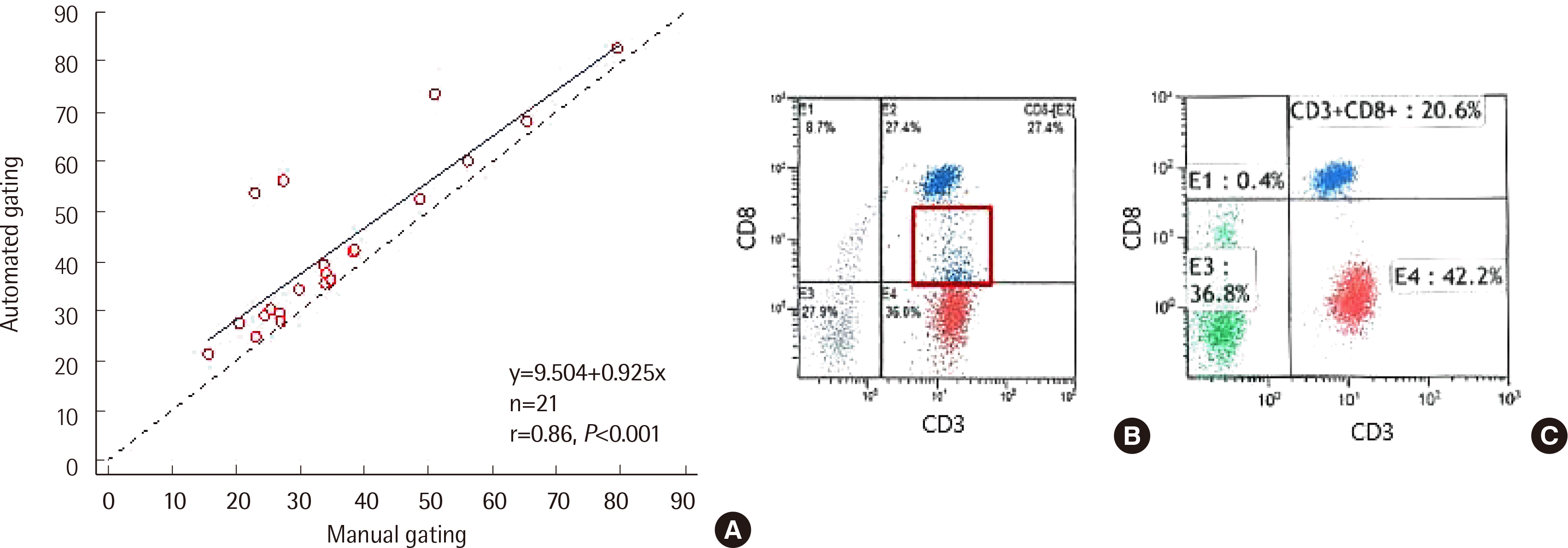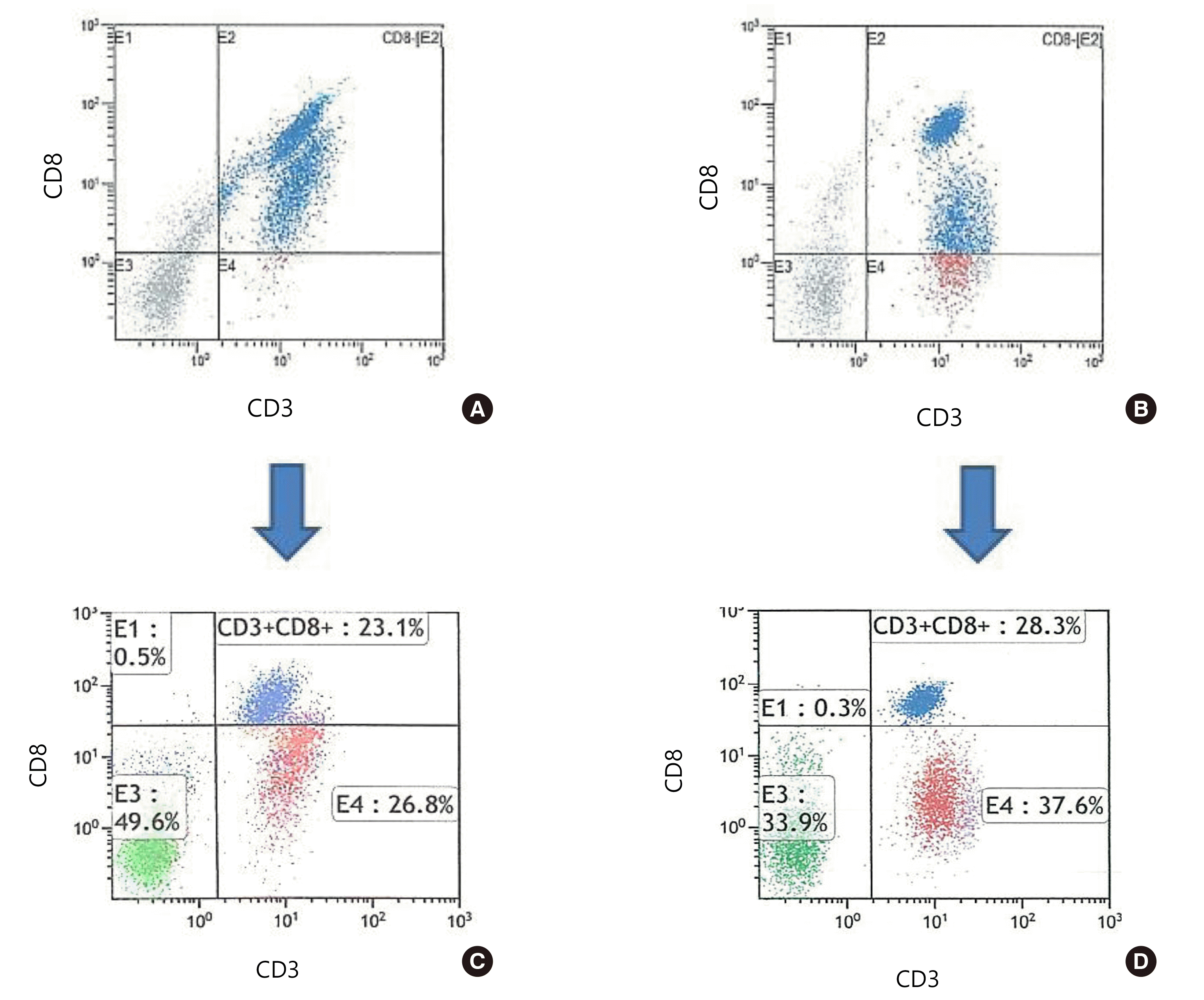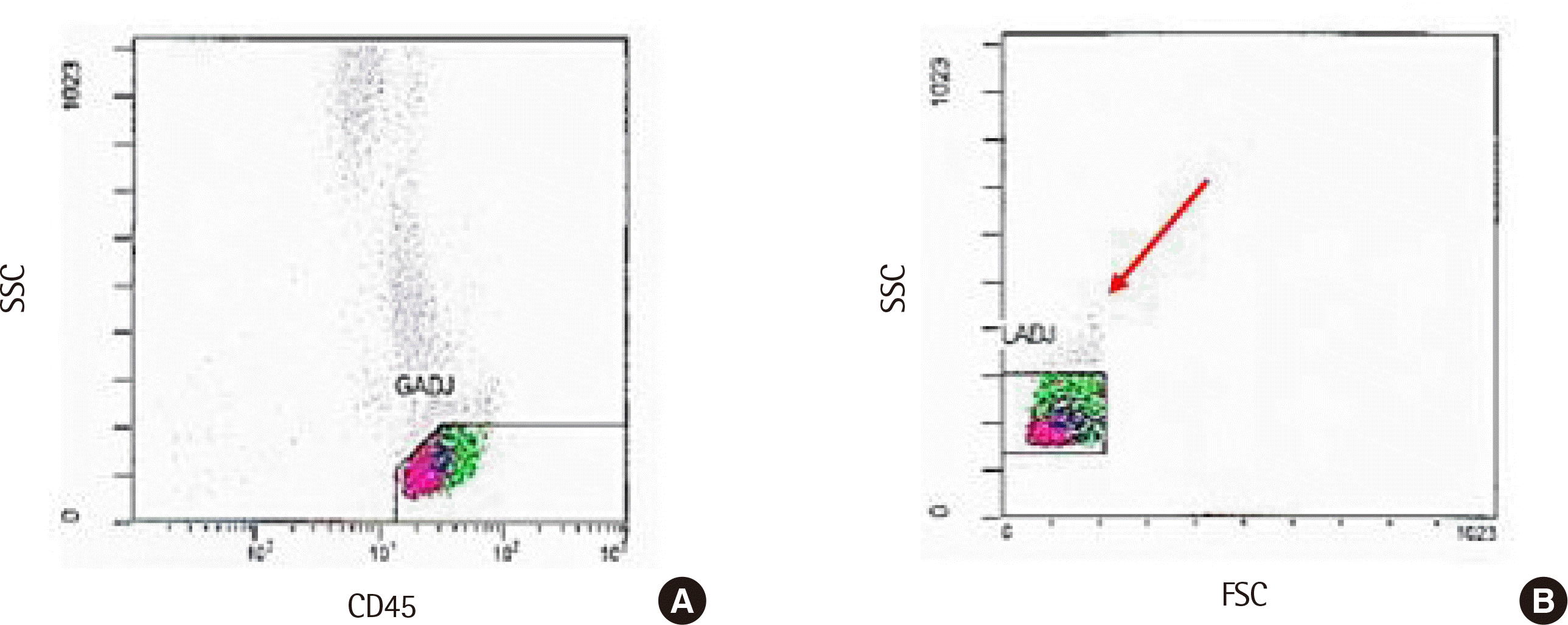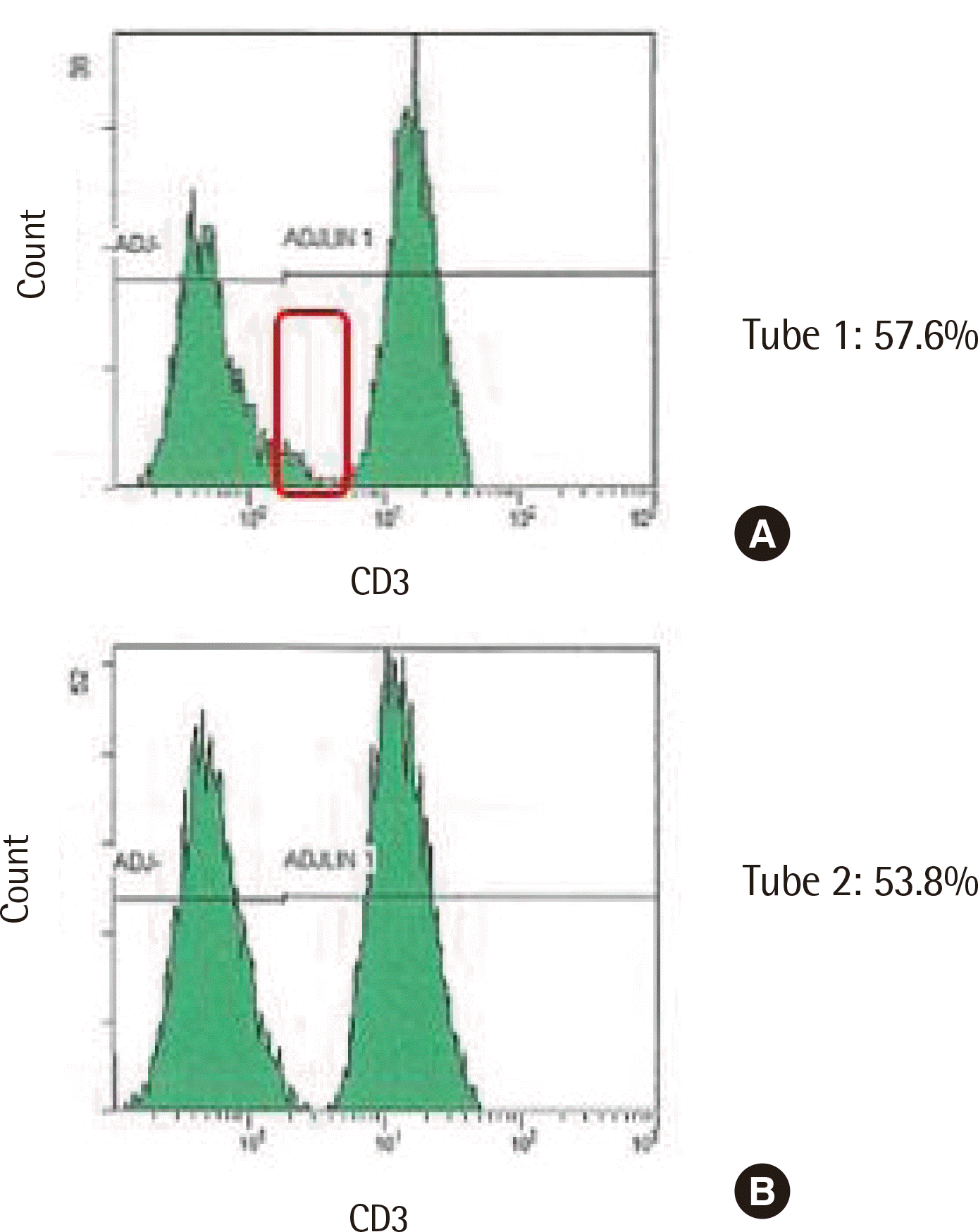2. Storek J, Dawson MA, Storer B, Stevens-Ayers T, Maloney DG, Marr KA, et al. 2001; Immune reconstitution after allogeneic marrow transplantation compared with blood stem cell transplantation. Blood. 97:3380–9. DOI:
10.1182/blood.V97.11.3380. PMID:
11369627.

3. Savani BN, Rezvani K, Mielke S, Montero A, Kurlander R, Carter CS, et al. 2006; Factors associated with early molecular remission after T cell-depleted allogeneic stem cell transplantation for chronic myelogenous leukemia. Blood. 107:1688–95. DOI:
10.1182/blood-2005-05-1897. PMID:
16131570. PMCID:
PMC1895415.

4. Kim DH, Sohn SK, Won DI, Lee NY, Suh JS, Lee KB. 2006; Rapid helper T-cell recovery above 200×10
6/l at 3 months correlates to successful transplant outcomes after allogeneic stem cell transplantation. Bone Marrow Transplant. 37:1119–28. DOI:
10.1038/sj.bmt.1705381. PMID:
16699530.
5. Williams KM, Gress RE. 2008; Immune reconstitution and implications for immunotherapy following haematopoietic stem cell transplantation. Best Pract Res Clin Haematol. 21:579–96. DOI:
10.1016/j.beha.2008.06.003. PMID:
18790456. PMCID:
PMC2577193.

6. Brinkman RR. 2020; Improving the rigor and reproducibility of flow cytometry-based clinical research and trials through automated data analysis. Cytometry A. 97:107–12. DOI:
10.1002/cyto.a.23883. PMID:
31515945. PMCID:
PMC8043840.

7. Montante S, Brinkman RR. 2019; Flow cytometry data analysis: Recent tools and algorithms. Int J Lab Hematol. 41(Suppl 1):56–62. DOI:
10.1111/ijlh.13016. PMID:
31069980.

8. Frelinger J, Ottinger J, Gouttefangeas C, Chan C. 2010; Modeling flow cytometry data for cancer vaccine immune monitoring. Cancer Immunol Immunother. 59:1435–41. DOI:
10.1007/s00262-010-0883-4. PMID:
20563720. PMCID:
PMC2892609.

9. Meehan S, Walther G, Moore W, Orlova D, Meehan C, Parks D, et al. 2014; AutoGate: automating analysis of flow cytometry data. Immunol Res. 58:218–23. DOI:
10.1007/s12026-014-8519-y. PMID:
24825775. PMCID:
PMC4464812.

10. Flores-Montero J, Grigore G, Fluxá R, Hernández J, Fernandez P, Almeida J, et al. 2019; EuroFlow Lymphoid Screening Tube (LST) data base for automated identification of blood lymphocyte subsets. J Immunol Methods. 475:112662. DOI:
10.1016/j.jim.2019.112662. PMID:
31454495.

11. Verschoor CP, Lelic A, Bramson JL, Bowdish DM. 2015; An introduction to automated flow cytometry gating tools and their implementation. Front Immunol. 6:380. DOI:
10.3389/fimmu.2015.00380. PMID:
26284066. PMCID:
PMC4515551.

12. Mair F, Hartmann FJ, Mrdjen D, Tosevski V, Krieg C, Becher B. 2016; The end of gating? An introduction to automated analysis of high dimensional cytometry data. Eur J Immunol. 46:34–43. DOI:
10.1002/eji.201545774. PMID:
26548301.

13. Conrad VK, Dubay CJ, Malek M, Brinkman RR, Koguchi Y, Redmond WL. 2019; Implementation and validation of an automated flow cytometry analysis pipeline for human immune profiling. Cytometry A. 95:183–91. DOI:
10.1002/cyto.a.23664. PMID:
30570217.

14. Aghaeepour N, Finak G, Hoos H, Mosmann TR, Brinkman R, Gottardo R, et al. 2013; Critical assessment of automated flow cytometry data analysis techniques. Nat Methods. 10:228–38. DOI:
10.1038/nmeth.2365. PMID:
23396282. PMCID:
PMC3906045.

15. Mandy FF, Nicholson JK, McDougal JS. 2003; Guidelines for performing single-platform absolute CD4+ T-cell determinations with CD45 gating for persons infected with human immunodeficiency virus. Centers for Disease Control and Prevention. MMWR Recomm Rep. 52:1–13. PMID:
12583540.
16. Linskens E, Diks AM, Neirinck J, Perez-Andres M, De Maertelaere E, Berkowska MA, et al. 2020; Improved standardization of flow cytometry diagnostic screening of primary immunodeficiency by software-based automated gating. Front Immunol. 11:584646. DOI:
10.3389/fimmu.2020.584646. PMID:
33224147. PMCID:
PMC7667243.

17. Trautmann A, Rückert B, Schmid-Grendelmeier P, Niederer E, Bröcker EB, Blaser K, et al. 2003; Human CD8 T cells of the peripheral blood contain a low CD8 expressing cytotoxic/effector subpopulation. Immunology. 108:305–12. DOI:
10.1046/j.1365-2567.2003.01590.x. PMID:
12603596. PMCID:
PMC1782903.

18. Ouyang L, Li X, Liang Z, Yang D, Gong F, Shen G, et al. 2013; CD8
low T-cell subpopulation is increased in patients with chronic hepatitis B virus infection. Mol Immunol. 56:698–704. DOI:
10.1016/j.molimm.2013.07.003. PMID:
23933510.
19. Marins-Dos-Santos A, Olivieri BP, Ferreira-Reis R, de Meis J, Silva AA, de Araújo-Jorge TC, et al. 2020; CD8
low T cells expanded following acute
Trypanosoma cruzi infection and benznidazole treatment are a relevant subset of IFN-gamma producers. PLoS Negl Trop Dis. 14:e0008969. DOI:
10.1371/journal.pntd.0008969. PMID:
33347472. PMCID:
PMC7785226.
20. Liu B, Ma Y, Zhang Y, Zhang C, Yi J, Zhuang R, et al. 2015; CD8
low CD100- T cells identify a novel CD8 T cell subset associated with viral control during human Hantaan virus infection. J Virol. 89:11834–44. DOI:
10.1128/JVI.01610-15. PMID:
26378166. PMCID:
PMC4645342.
21. Xu H, Wang X, Lackner AA, Veazey RS. 2013; CD8 down-regulation and functional impairment of SIV-specific cytotoxic T lymphocytes in lymphoid and mucosal tissues during SIV infection. J Leukoc Biol. 93:943–50. DOI:
10.1189/jlb.1112580. PMID:
23519937. PMCID:
PMC3656336.

22. Favre D, Stoddart CA, Emu B, Hoh R, Martin JN, Hecht FM, et al. 2011; HIV disease progression correlates with the generation of dysfunctional naive CD8
low T cells. Blood. 117:2189–99. DOI:
10.1182/blood-2010-06-288035. PMID:
21200021. PMCID:
PMC3062328.
23. Overgaard NH, Jung JW, Steptoe RJ, Wells JW. 2015; CD4
+/CD8
+ double-positive T cells: more than just a developmental stage? J Leukoc Biol. 97:31–8. DOI:
10.1189/jlb.1RU0814-382. PMID:
25360000.
24. Alhaj Hussen K, Michonneau D, Biajoux V, Keita S, Dubouchet L, Nelson E, et al. 2020; CD4
+CD8
+ T-lymphocytes in xenogeneic and human graft-versus-host disease. Front Immunol. 11:579776. DOI:
10.3389/fimmu.2020.579776. PMID:
33329550. PMCID:
PMC7732609.
25. Forconi CS, Oduor CI, Oluoch PO, Ong'echa JM, Münz C, Bailey JA, et al. 2020; A New Hope for CD56
negCD16
pos NK cells as unconventional cytotoxic mediators: An adaptation to chronic diseases. Front Cell Infect Microbiol. 10:162. DOI:
10.3389/fcimb.2020.00162. PMID:
32373555. PMCID:
PMC7186373.

26. Hu PF, Hultin LE, Hultin P, Hausner MA, Hirji K, Jewett A, et al. 1995; Natural killer cell immunodeficiency in HIV disease is manifest by profoundly decreased numbers of CD16
+CD56
+ cells and expansion of a population of CD16
dimCD56
- cells with low lytic activity. J Acquir Immune Defic Syndr Hum Retrovirol. 10:331–40. DOI:
10.1097/00042560-199511000-00005. PMID:
7552495.
27. Jacobson A, Bell F, Lejarcegui N, Mitchell C, Frenkel L, Horton H. 2013; Healthy neonates possess a CD56-negative NK cell population with reduced anti-viral activity. PLoS One. 8:e67700. DOI:
10.1371/journal.pone.0067700. PMID:
23805324. PMCID:
PMC3689709.

28. De Angelis C, Mancusi A, Ruggeri L, Capanni M, Urbani E, Velardi A, et al. 2011; Expansion of CD56-negative, CD16-positive, KIR-expressing natural killer cells after T cell-depleted haploidentical hematopoietic stem cell transplantation. Acta Haematol. 126:13–20. DOI:
10.1159/000323661. PMID:
21411985.

29. Milush JM, López-Vergès S, York VA, Deeks SG, Martin JN, Hecht FM, et al. 2013; CD56
negCD16
+ NK cells are activated mature NK cells with impaired effector function during HIV-1 infection. Retrovirology. 10:158. DOI:
10.1186/1742-4690-10-158. PMID:
24351015. PMCID:
PMC3892122.

30. Van Acker HH, Capsomidis A, Smits EL, Van Tendeloo VF. 2017; CD56 in the immune system: more than a marker for cytotoxicity? Front Immunol. 8:892. DOI:
10.3389/fimmu.2017.00892. PMID:
28791027. PMCID:
PMC5522883.

31. Lu X, Kondo Y, Takamatsu H, Ohata K, Yamazaki H, Takami A, et al. 2008; CD16
+ CD56
- NK cells in the peripheral blood of cord blood transplant recipients: a unique subset of NK cells possibly associated with graft-versus-leukemia effect. Eur J Haematol. 81:18–25. DOI:
10.1111/j.1600-0609.2008.01073.x. PMID:
18363874.
32. Clinical, Laboratory Standards Institute. 2007. Enumeration of immunologically defined cell populations by flow cytometry; Approved guideline-Second edition. CLSI document H42-A2. Clinical and Laboratory Standards Institute,;Wayne, PA: p. 18p. 21–22.
33. Diallo TO, Bergeron M, Seely P, Yang X, Ding T, Plews M, et al. 2017; Automation for clinical CD4 T-cell enumeration, a desirable tool in the hands of skilled operators. Cytometry B Clin Cytom. 92:445–50. DOI:
10.1002/cyto.b.21370. PMID:
26990810.

34. Wood B, Jevremovic D, Bene MC, Yan M, Jacobs P, Litwin V, et al. 2013; Validation of cell-based fluorescence assays: practice guidelines from the ICSH and ICCS - part V - assay performance criteria. Cytometry B Clin Cytom. 84:315–23. DOI:
10.1002/cyto.b.21108. PMID:
24022854.







 PDF
PDF Citation
Citation Print
Print





 XML Download
XML Download